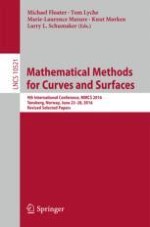2017 | Buch
Mathematical Methods for Curves and Surfaces
9th International Conference, MMCS 2016, Tønsberg, Norway, June 23–28, 2016, Revised Selected Papers
herausgegeben von: Prof. Dr. Michael Floater, Prof. Tom Lyche, Marie-Laurence Mazure, Knut Mørken, Larry L. Schumaker
Verlag: Springer International Publishing
Buchreihe : Lecture Notes in Computer Science
